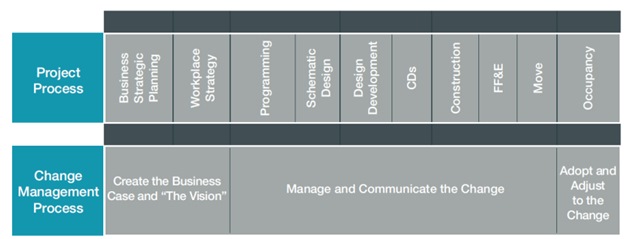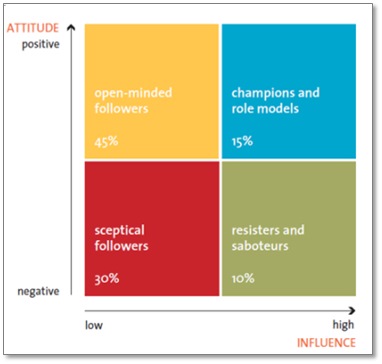by Diane Coles Levine — July 2017 — People often have a fight-or-flight response to change. The workplace change management process helps employees shift their thinking and behavior from resisting change to embracing their new work environment. It is a structured approach that coincides with the workplace strategy, design and construction schedule. The goal is to minimize the inherent threat of change and ensure that employees are productive on day one in their new work space. When done properly, workplace change management will make the life of a Facility Manager easier when implementing a workplace transformation.
This article will discuss the six keys to a successful workplace change management program.
1. Launch early
Change management practices are designed to uncover any leadership and staff concerns with the new workplace environment. Early discovery of controversial issues and employee concerns means they can be resolved sooner rather than later to prevent unnecessary future changes in architectural and construction plans. The change management process should start at the beginning of the workplace strategy development and design process and before real estate site selection (see Figure 1: Change Management and Design Process) Starting at the beginning of the process helps save money and avoid costly change orders along with unhappy, disengaged and unproductive staff.
Deferring change management later in the design process runs the risk of budget increases, costly construction modifications, delays and dissatisfied or underperforming employees. For example, a sportswear company hired a change manager after they started construction. It was too late for the change manager to work with senior executives on changing employee attitudes and behaviors and, at this juncture, it becomes a “change communications” project rather than “change management.” The change manager was simply communicating executive decisions rather than gaining acceptance from the beginning. Change communications is not the same as change management. If your change in the workplace requires change in attitudes and behaviors, it is an organizations responsibility to help their employees overcome their natural resistance to that change. Starting too late in the process can detrimentally impact the results you are seeking.
2. Use data and evidence-based design research to back up business decisions, analyze success and make the change stick
There are three major uses of data to sell your workplace transformation project. Let’s look at each one in more detail.
- Understand the business case for change
It’s very important that company leaders are “transparent” and “honest” about the reasons and capacity for A thorough analysis of the risks and opportunities associated with the proposed change and an understanding of the gains, costs and threats of making or not making the change is essential. This includes a readiness assessment of the organizations’ capacity to execute change. The business case sets the stage to create the common vision and obtain buy-in throughout the communication strategy. The more people who understand why the change is needed, and share a desire to make it happen, the more likely the change program will succeed. - Use science to explain design decisions
Designing with science using evidence-based design research is essential in any workplace. As companies move toward a “work anywhere” approach, it is important to understand what the research says to avoid costly design mistakes and employee dissatisfaction. Research can also facilitate better communication with employees about the basis and reasons for workplace design decisions to minimize their concerns. For example, a Harvard University study discovered that watching employees work may actually reduce their performance, while creating zones of privacy can, under some circumstances, increase operational output. - Measure success of your workplace project
The success measures help make the change stick by assessing the results to ensure adoption to new ways of working and making adjustments as needed. Some examples of success measures include return on investment, density of occupation, space utilization, pre and post-occupancy survey, productivity, employee satisfaction, employee engagement, turnover, building costs, meeting room usage, and more. By tracking this data, a healthcare company in Southern California was able to re-sell the workplace change after there was a change in the CEO, CFO, and COO. With a new CEO, staff were concerned that the change was not going to stick and the space would go back to “the way things were.” The Facilities team had the data to back up their decisions and the staff were able to continue with their flexible work program and workplace strategy.
3. Get senior level sponsorship that is engaged in the project
Workplace change will not happen if senior executives are not on board. It is critical to get buy in of leadership and figure out how transformational your new workplace is going to be. Once this is determined, they will need their wherewithal to stay with it and get people excited and involved. It’s best to work with executives to lay out the reasons for making the change from a cultural, financial operational perspective.
It is important that executives model the behaviors they wish to occur with your change initiative. One CEO of a technology company in Arizona understood the impact that taking breaks throughout the day has on productivity, and he verbally encouraged his employees to “get outside, take a walk.” However, he noticed that very few people were actually doing so. His response? He would walk through the floors, loudly exclaiming, “I am going outside to get some air!” He called this “leaving by example.”
When senior executives model the desired behaviors, staff will follow. A CEO of a health care company in Southern California said, ”It was important that we address symbolic things. the CEO and senior executives’ offices were reduced in size. This showed the staff that we were all in it together. Those kinds of things were really important. It couldn’t be just be the staff that had to change. We, as executives, also had to change.”
4. Use change agents or ambassadors actively representing business units
The best way to manage the change is to appoint and empower a committee of changes agents who advocate for their departments and for the improvements coming in the new space. These change agents are an integral part of the change process and act as a link, selling the change, helping to dispel rumors and bringing insights and observations back to the change management and project team.
Appointing resistors and detractors as change advocates will aid in testing the merits of the change approach. Research shows that resistors provide high influence over others. You can positively influence 75% of the population by focusing on just 25%. In other words, the resistors and champions and role models (see Figure 2: Overcome Resistance to Change). Resistors can be difficult in the beginning but will pay off in the long run as saboteurs become highly influential and loyal advocates. While they can be demanding, I find that resistors can also be an asset to your workplace strategy and often bring up issues from new and different perspectives.
The change ambassadors, along with senior executives can help to manage the message and sell the business case. When SCAN Health embarked on their workplace change, the economy collapsed. Everyone was asking “Why are we spending so much money on furniture during an economic crisis?” The CEO, CFO and change ambassadors acted like broken records repeating the $7 million cost savings over and over again until the staff were repeating it to each other.
5. Develop a communication program that is well thought out with participation by employees and change agents
Communicate the workplace vision and business case for change for understanding and buy-in. The idea is to make sure as many employees as possible understand and accept the vision and strategy. Change communications ensures that the people affected by the change understand the change and are prepared for the transformation. The business case for change and the workplace vision form the basis of the communication messages and explains the “value” of what employees will gain in their new workspace. The key is to be as transparent as possible and share the facts. Effective communications is multi-pronged, targeted to specific audiences and maintained throughout the life of the project. For employees, it’s all about the WIIFM (“What’s in it for Me”) They expect clear, concise, honest and consistent messages.
Again…transparency.
The earlier the communications the better as it takes time for people to adjust mentally to a workplace change. Workers want to know about the new building, local amenities, furniture, technology, space design, construction and move schedule and, in general, how the transformation affects them. A previous article on this site titled “Workplace Change Management: Are you communicating the right information at the right time to head off rumors and resistance to change?” provides more detailed information on this topic and change activities such as mock-ups, pilot programs, tours, special events, contests, etc.
6. Keep the change program in place long after the move
Change is deemed successful when it becomes the “new normal.” Workshops or guidance sessions are a great way for both managers and employees to understand the preferred new behaviors and workplace practices and can reinforce the change, ensuring success until they become part of the culture. Workshops should continue long after the move and continually improve and evolve with the workplace strategy. Continuous marketing, communications and data collection about the workplace and how employees are evolving and adapting to new ways of working is important. Remember, workplace strategy is always evolving to continually align with the organization.
Summary
Change management helps employees get back to work quickly and effectively and in return reduce costs and minimizes productivity/performance loss. People and space represent the two largest portions of a company’s budget and a smooth change management program helps optimize these assets by decreasing costs and attracting & retaining high performers. A well-planned change management program reduces stress, improves employee engagement and well-being along with their overall satisfaction with the company. This is important in the new war for talent. Following these six keys will ensure success.
Diane Coles Levine is the Executive Director of the IFMA Foundation. Previously, she was the founder and managing Partner at Workplace Management Solutions. She served on the IFMA Board of Directors, is Past Chair of the IFMA Foundation and was named the 2015 IFMA Corporate Real Estate Council Distinguished Member. She is an international speaker and guest lecturer at Vienna University of Technology and MIT Professional Education Programs. Diane is co-editor and author of Work on the Move.

